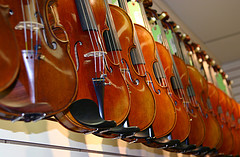The violin Play the Violin - A Whole Novice's Guide - The violin, also known as a fiddle, is a bowed string instrument. It has four strings that are tuned in perfect fifths. The violin is the smallest and highest pitched member of the string instrument family, which also includes violas and cellos. Although playing the violin can be quite challenging, when mastered, it produces a… as we know it today evolved from early stringed instruments around the 15th century. These instruments sometimes had only two strings, but like the violin, they were also played with a bow. Two prominent “schools” of violin-making emerged in the 16th century. The Cremonese school was founded by a renowned craftsman of that era, Andrea Amati. Around the same time, another notable maker, Gasparo da Salo, was part of the Brescian school. During this period, all violin production took place in Italy. Later, in the 17th century, exceptional violins began to be crafted in Germany as well.
The most distinguished violin makers of all time were Stradivari and Guarneri. Both of these Italian master craftsmen created violins in the early 18th century. Violins from either of these two masters are highly prized and sought after around the world. The finest professional violinists today play one of their instruments. There was also a prominent German violin maker of this time named Jacobus Stainer, but he did not attain the same level of fame as the Italian makers.
The sound quality of the Stradivarius and Guarneri violins is considered the best in the world. Although there were high-quality violins produced after the 18th century, and excellent violins are still being made today, they do not possess the same rich tonal characteristics as the violins crafted by these early masters. There has been much research and speculation as to why this is. Some believe it was due to the quality of the wood used at that time, the transportation method of floating logs down a river, the expertise of the craftsmen, or the aging of the wood and the varnish over centuries, which contribute to their unique sound.
However, others believe it has more to do with the wood “filler” used prior to varnishing and possibly the varnish itself. It is now possible to replicate a Stradivarius or Guarneri violin in every way, using the same type of aged wood and employing the same dimensions, techniques, and tools. However, before varnishing, a newly made violin was coated with a liquid to fill the microscopic gaps in the wood so that the varnish would not be absorbed but instead create a smooth, even finish. It is this “filler” that modern violin makers and restorers cannot reproduce. Today’s violin makers do not know what was used by the early masters and therefore cannot replicate it. Some craftsmen spend considerable time experimenting with various formulas in an attempt to uncover the “secret,” but it has eluded them so far. Moreover, the varnish used today is a quick-drying type, whereas the old varnishes took months to dry. Perhaps a combination of all these factors makes it impossible to precisely replicate the sound of the early masters’ violins, despite being able to physically reproduce them.
While duplicating the sound of a Stradivarius is unattainable, fortunately, learning to play like a master violinist is achievable. Though it requires dedication and focused practice, the techniques used by today’s master violinists can be learned by the serious student, who may one day also become a master violinist capable of teaching others.
Manuel Marino is a seasoned Senior Producer, Music Composer, and Artist with over a decade of experience. He specializes in branded entertainment across various mediums, including video games, films, and advertising campaigns. With 20+ years as a game music composer, Manuel has worked on numerous platforms, creating diverse orchestral soundtracks. HIRE ME


 Manuel is a passionate, driven, and techsavvy AV technician,
Manuel is a passionate, driven, and techsavvy AV technician, 



